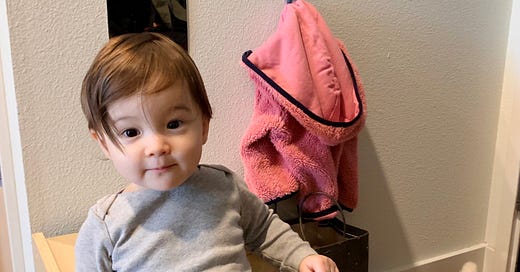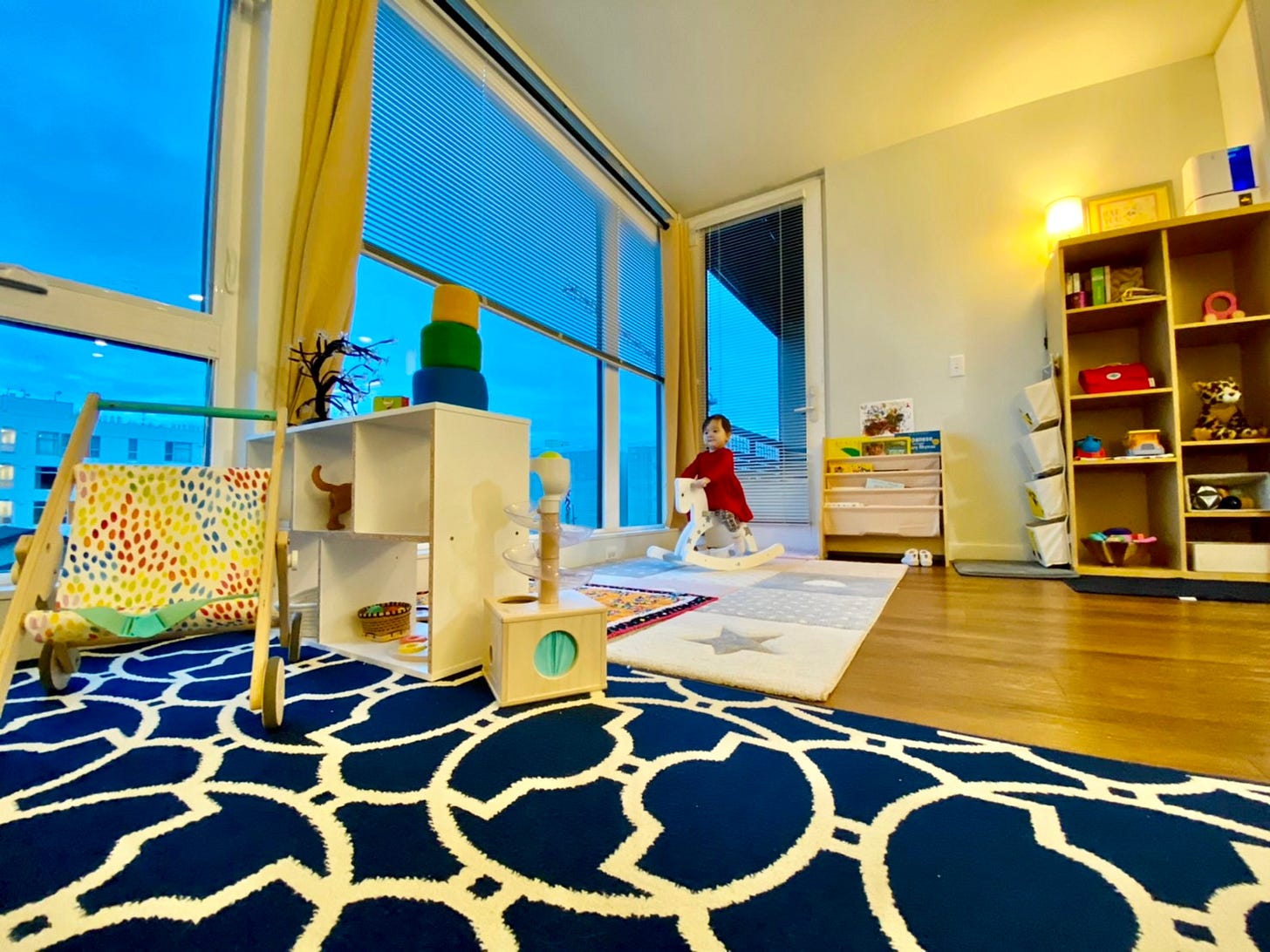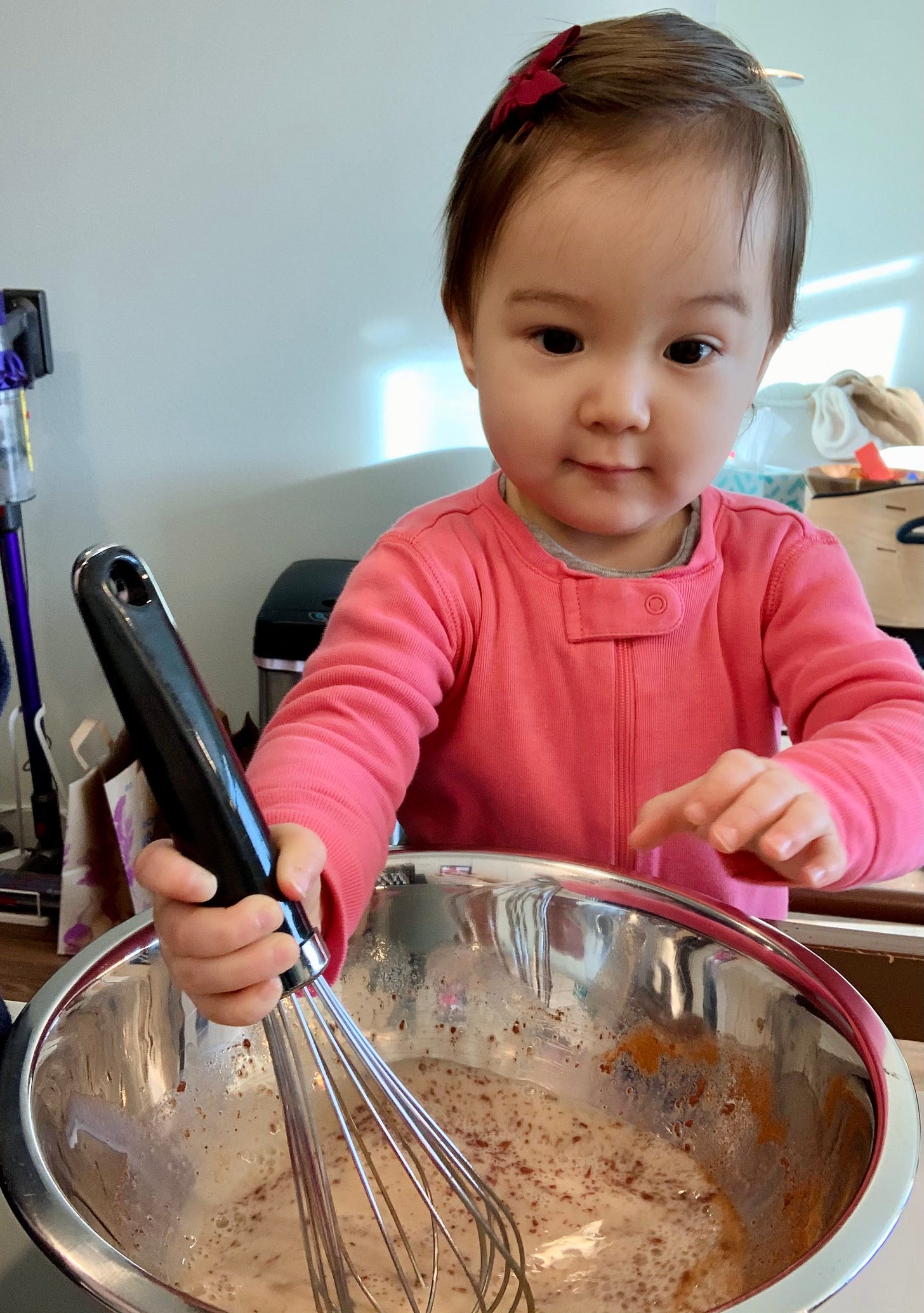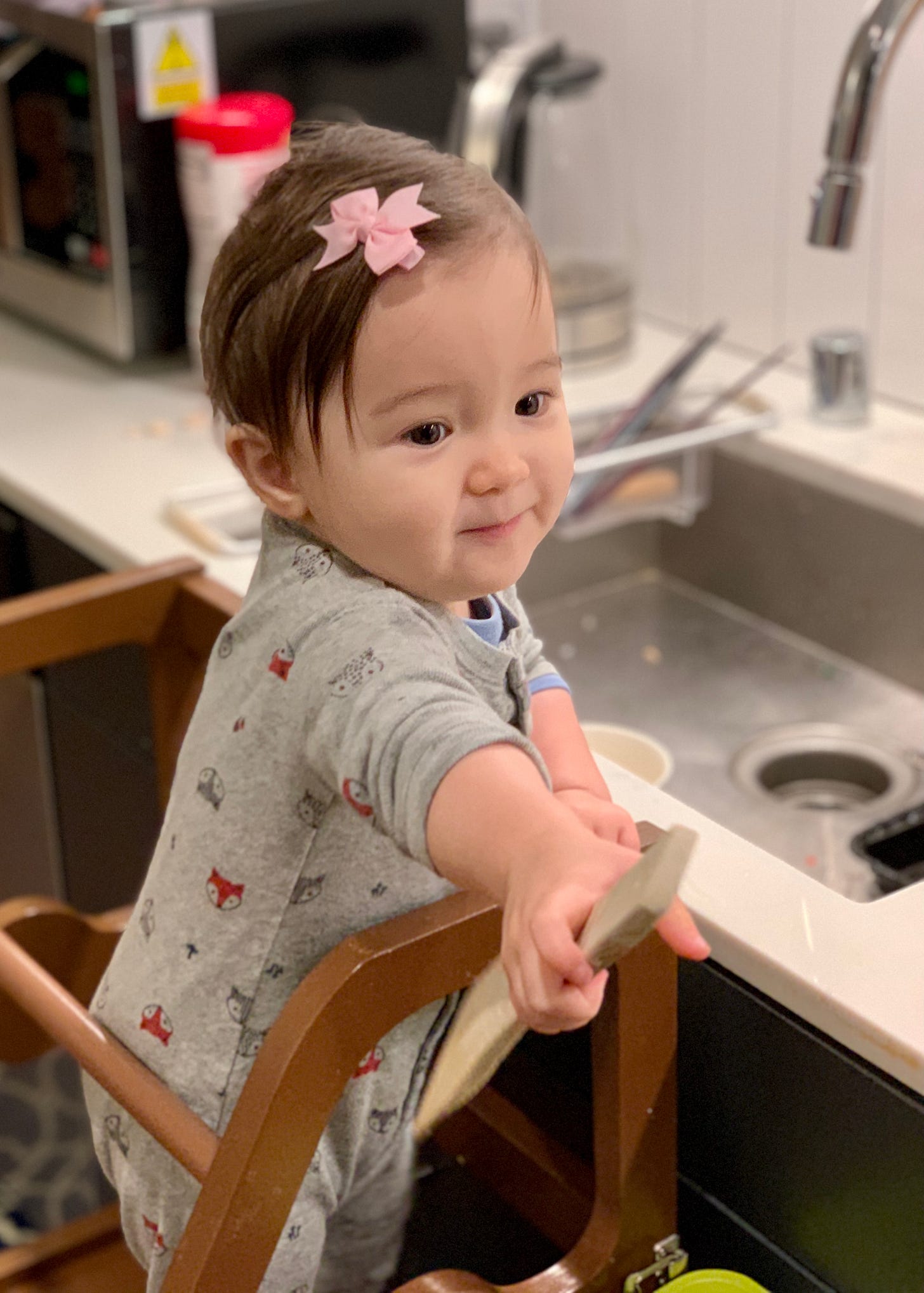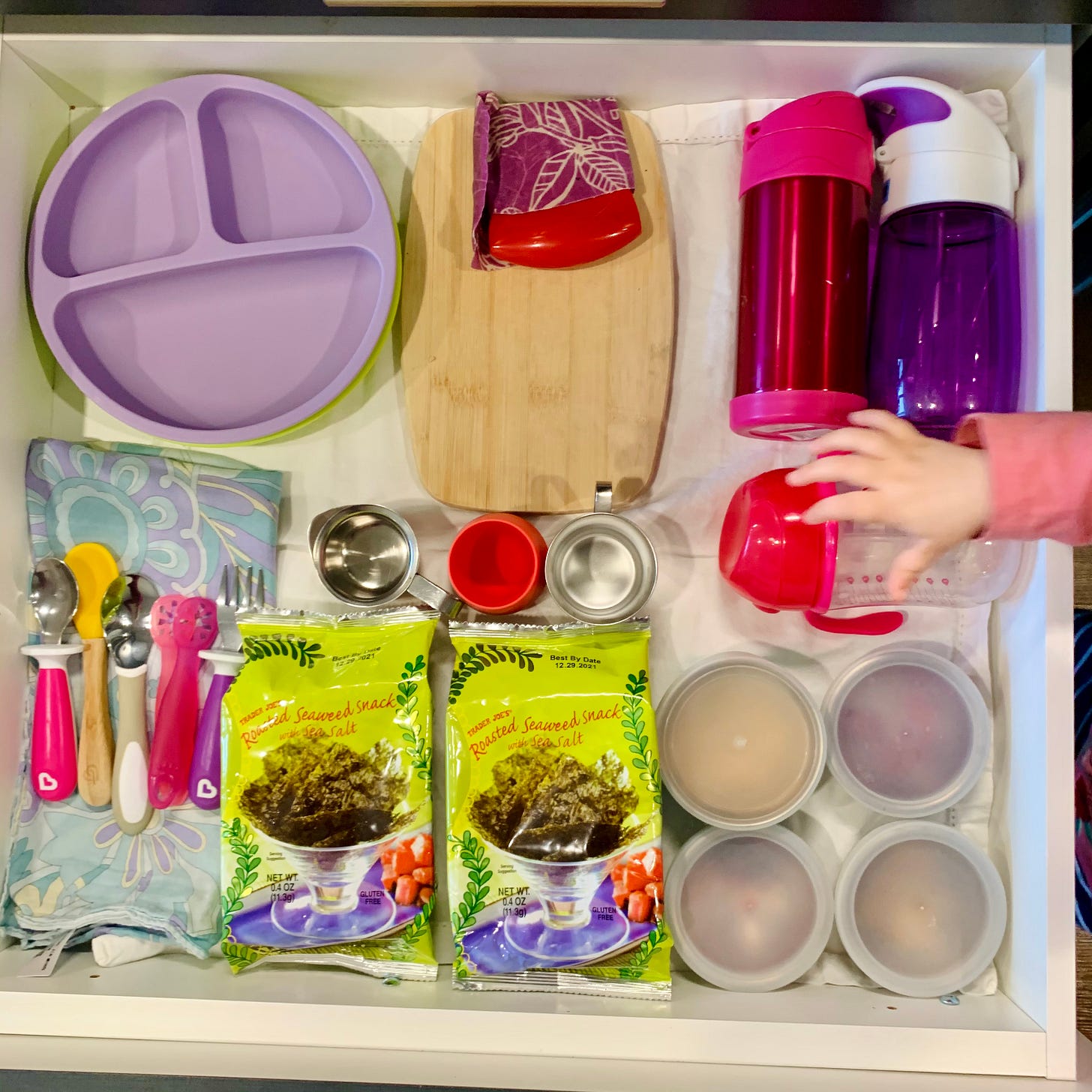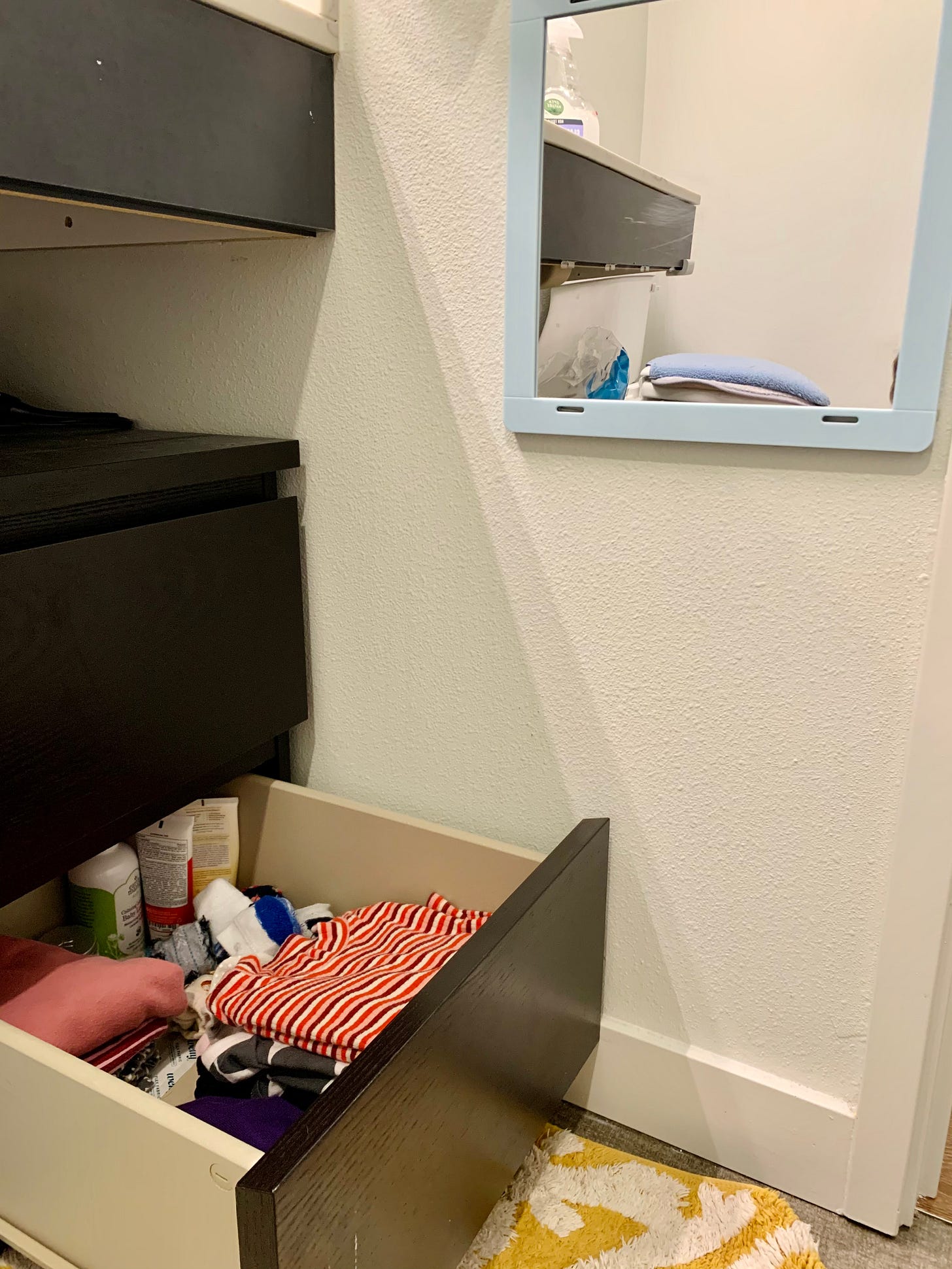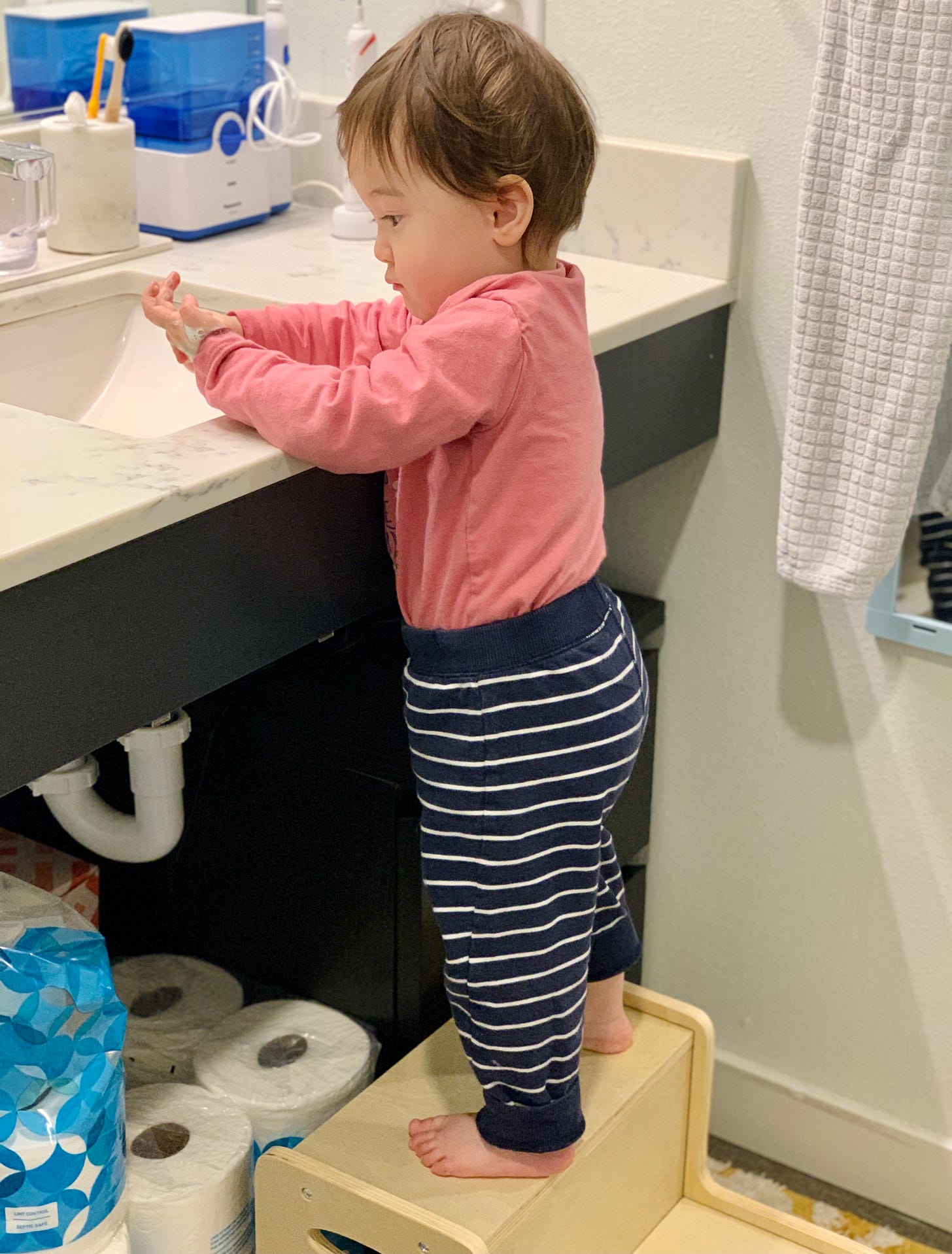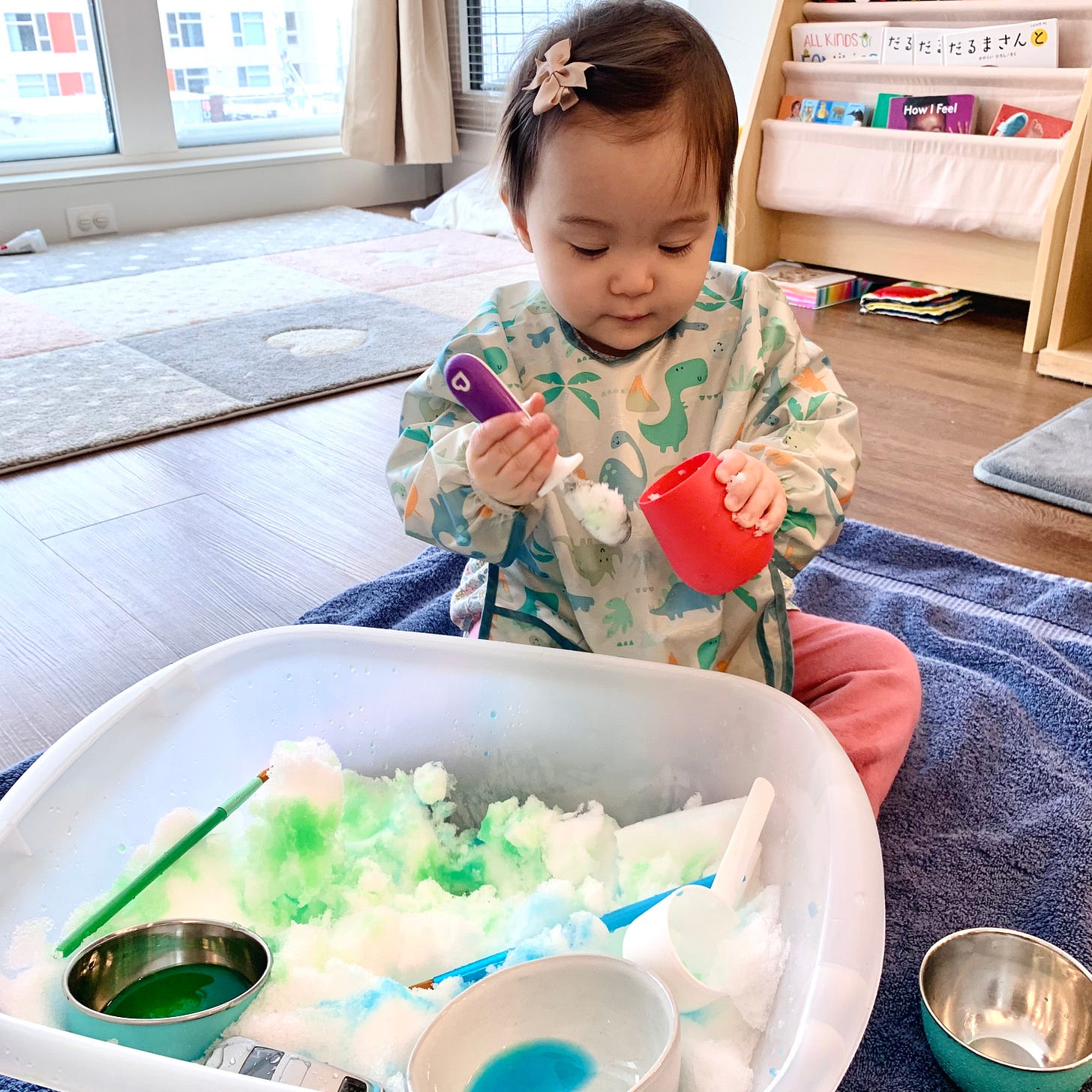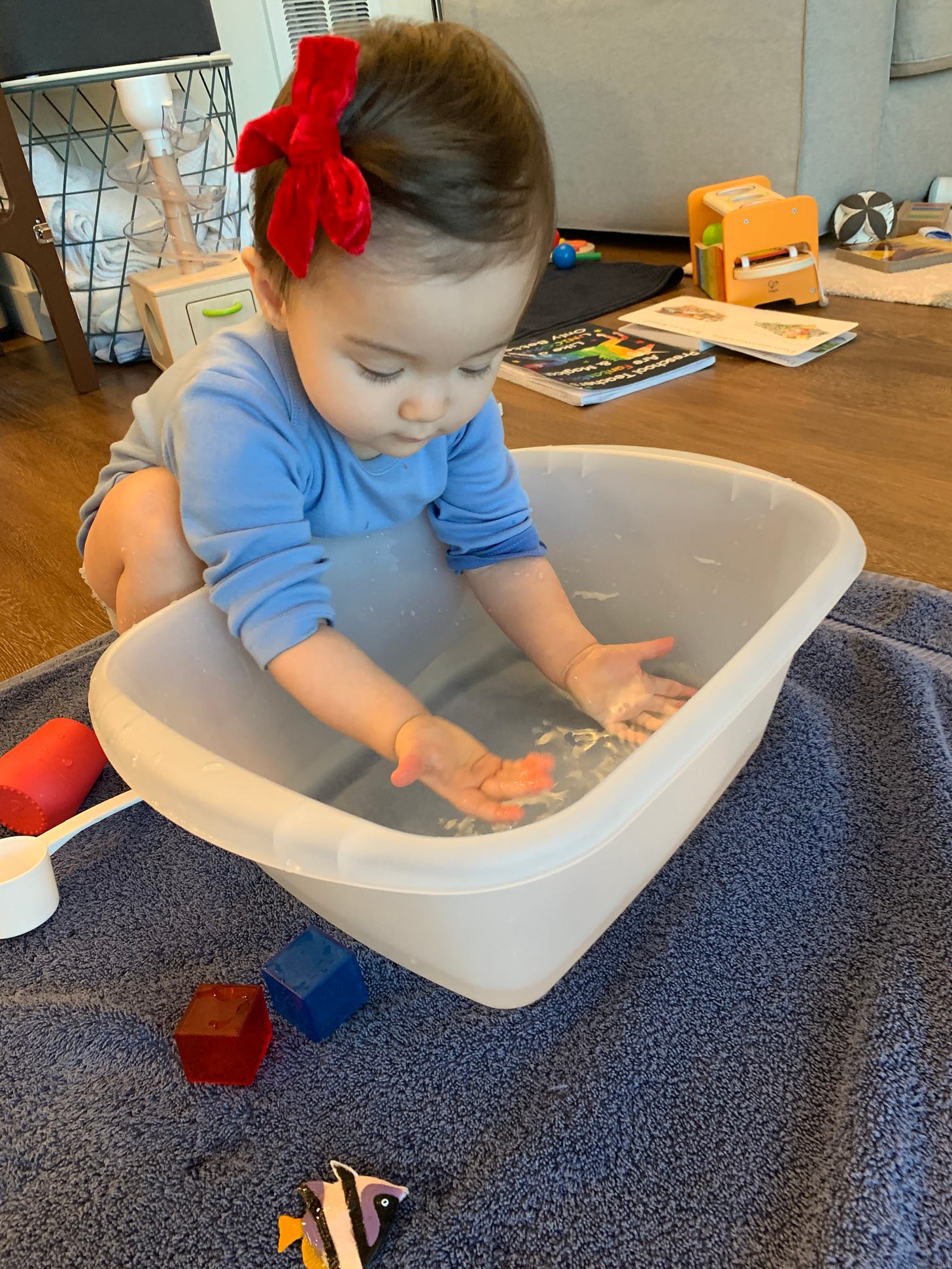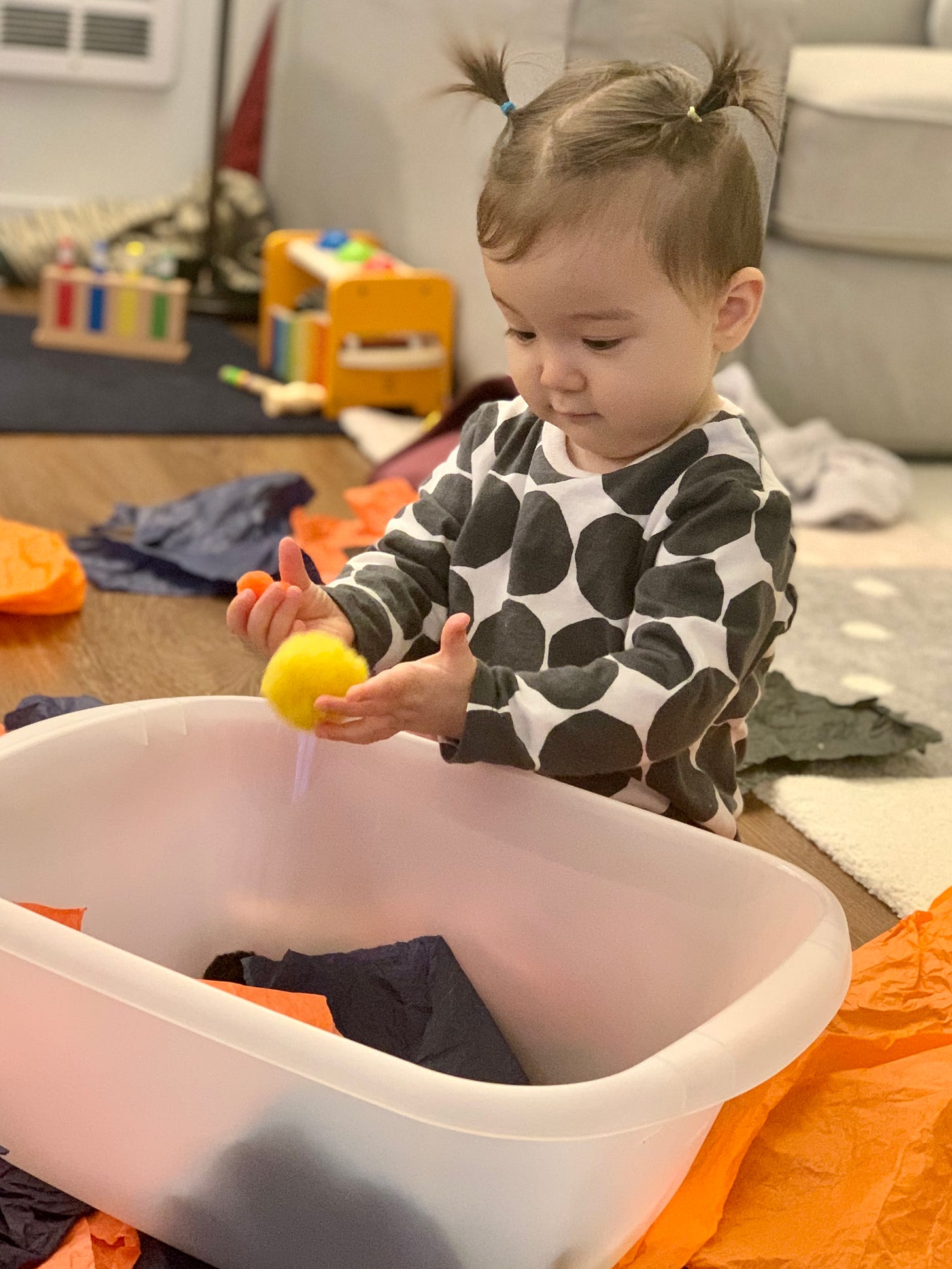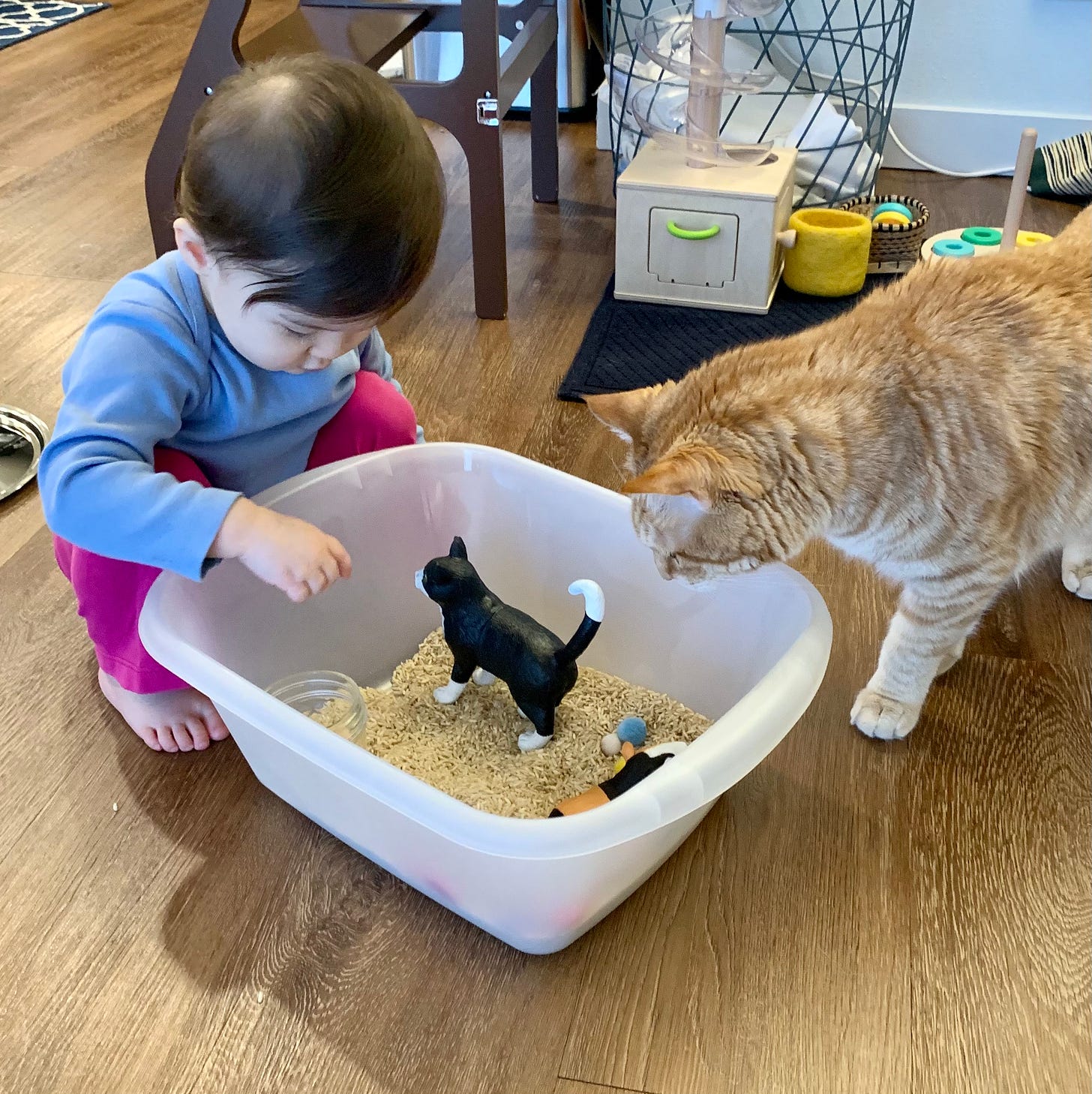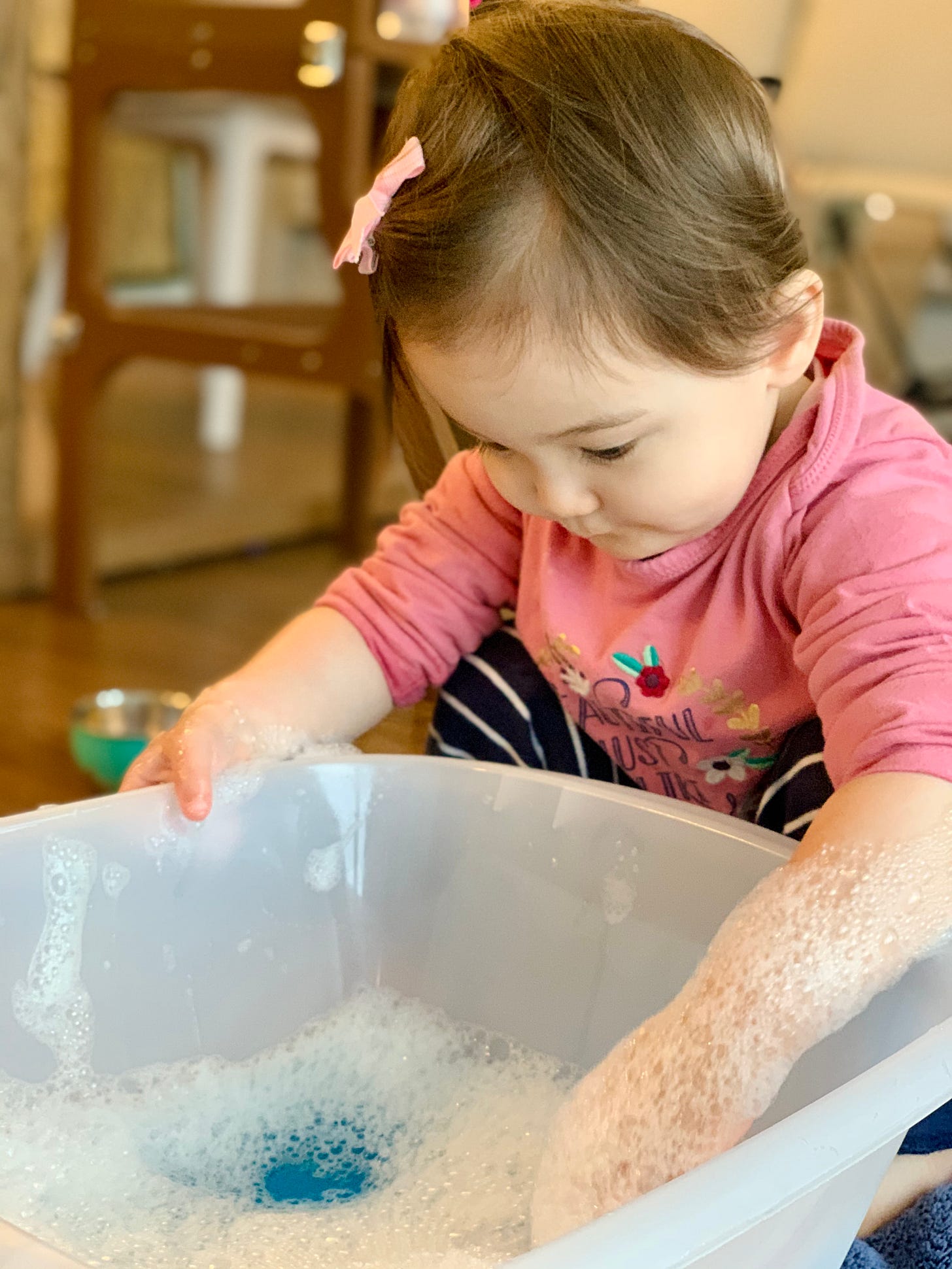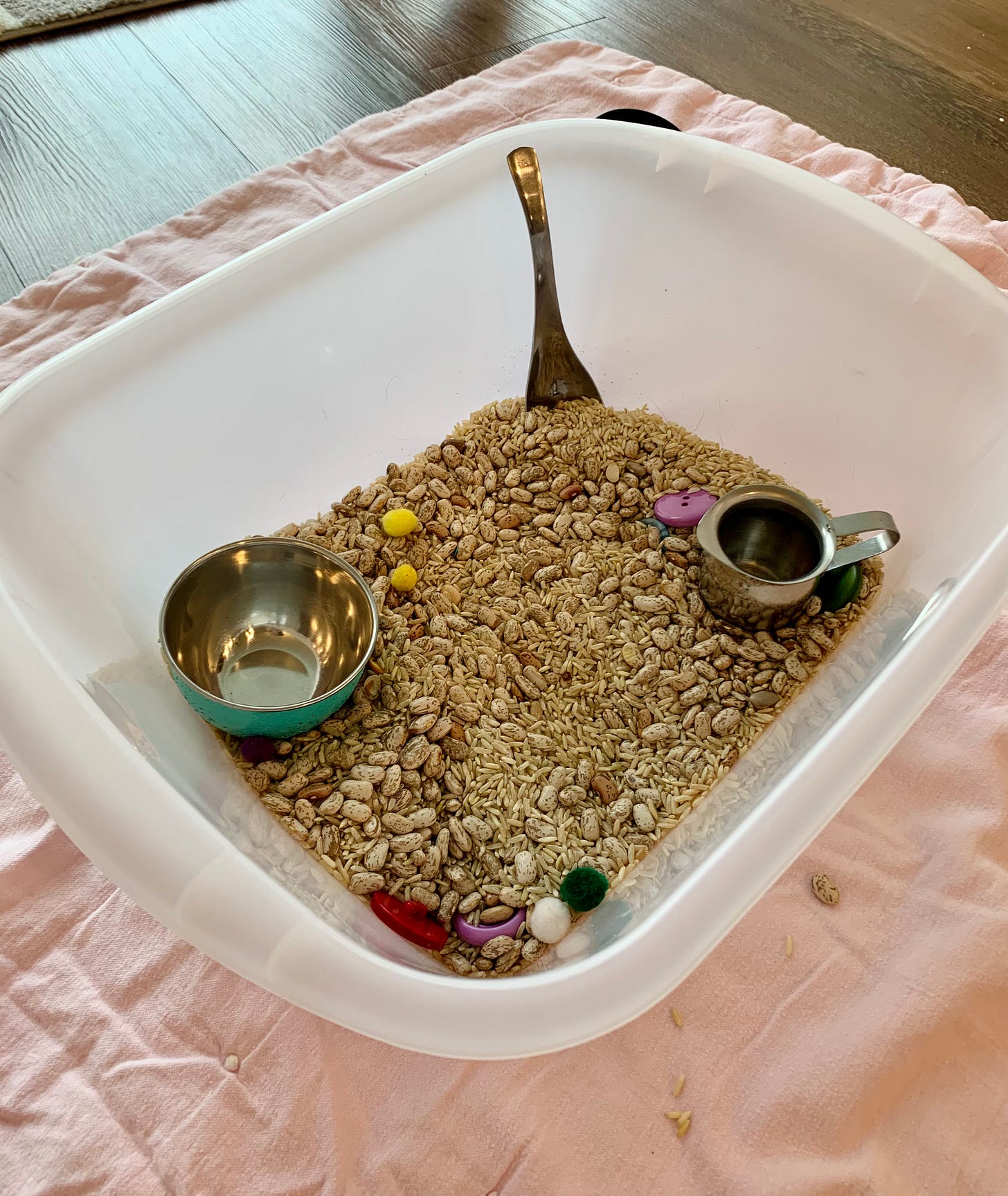Encouraging Independence and Growing Confidence in Young Children
Creating spaces (and tips for those in small spaces/on a budget) around your home to encourage independence and grow confidence in your child. Plus sensory bin inspiration!
Recently L has been surprising us with her depth of understanding and her joy at being able to do things for herself. She has really inspired this newsletter as I’ve been slowly making our home more accessible for her to be as independent as she would like!
Montessori and the Prepared Environment
In Montessori, classrooms are set up in a fundamental way that encourages order, independence and self motivation. This helps children learn with confidence how to take care of themselves and their environment. A child’s environment has a direct influence over what and how a child learns, which means that we should prepare our homes in a way that fosters our child’s natural curiosity and motivation! Here are some ideas to help you prepare your home environment for your child in a way that helps encourage independence, grow their confidence, and enhance their learning.
A Few Pointers to Get Started
Really, preparing the environment for children is about two elements: accessibility and order. Accessibility means that the materials children need are easy to access and easy for them to manipulate. This looks a little different depending on the area of the house you’re in. In the playroom, this means displaying toys and materials in a way that the child can see them easily and easily choose which material to interact with (usually through the use of a toy shelf or baskets on the floor). In the kitchen this could mean child sized utensils and a learning tower/stool they can use to access the counter. Order means that the materials are arranged or organized in a way that the child can easily understand what goes where. Everything should have a “place”. This sense of order sets the foundation for higher levels of thinking such as classification and also helps the child form their own sense of order in space and time.
The Playroom
This is probably the easiest space and your house to prepare. You can read my past newsletter all about setting up a Montessori playroom here. The main elements to think about in the playroom or play space is how to display materials in a way that promotes accessibility and order for your child. The simplest and most space saving way is by placing toys on a designated toy shelf. It varies greatly what families use, and you have to work with what is best for your family and living situation. Some families decided to put toys in baskets on the floor, others use the Kallax shelf from IKEA, others use a coffee table or TV stand. I also recommend a forward facing bookshelf like this one, if you have the space for it. Another option for storing books that has worked well for us in the past is a basket on the floor. This way your child will be able to see which book is which (remember they can’t read the title on the side of the book!) and it is easier for them to pull out the book they want than a traditional bookshelf. You can read more about setting up a Montessori playroom here.
The Kitchen
This is probably my favorite area of the house that I have prepared for L, mostly because she seems to get the most joy out of helping or observing in the kitchen. To make the kitchen more accessible to L, my first step was to buy a learning tower. This is simply a step stool that is made safer for young toddlers. You can see examples here and here. Although they can be expensive and take up some space (there are collapsible ones!!), ours has been worth every penny. They can often be found on Facebook marketplace for cheap as well! Of your child is a little older, a simple step stool would serve the same purpose. The learning tower allows L to be at the right height to take full advantage of the kitchen counter. She helps with prep work and will eventually be able to cook simple recipes from her learning tower. Another step I took to make the kitchen more accessible to L is to provide a toddler sized safe “knife” so she can learn to cut. Right now, she is just working on how to hold it and use it safely to cut a banana, but eventually she will use it to help prepare her own snacks and even help with meal prep.
I also gave L her own drawer in the kitchen that is at her height. Inside I put all her plates, cups, and utensils, her knife and cutting board, and her snacks. I put out only what I’m comfortable with her eating in one day. This provides her with some order as everything has its own spot the drawer and accessibility as she can independently get out her own snack and set her own spot at the table without help. This also gives her some responsibility to put her plates, cups, and utensils away from the dishwasher and get them out for meals.
Some Montessori families have their child help in the kitchen by doing meal prep at the table or even on the floor instead of using a step stool or learning tower for space reasons. Some families also use a weaning table to help make the kitchen table more accessible to their young children. If you have the space and resources, a lot of Montessori families use a “functional kitchen” for their young children. This is basically creating a child sized kitchen complete with running water (sometimes) for your child. You can see what I mean here and here. We don’t have one because we just don’t have the space, but I love the idea of one! It’s perfectly accessible and can be organized easily!
The Bathroom
In the bathroom, I made two changes to make it accessible and to add order for L. The first thing I did was add a mirror at L’s standing height so she can look in and watch the process of getting dressed and slowing learn how to dress herself. I also put two to three options of each type of clothing in a low drawer next to the mirror so she can choose her clothes each morning from those options. She also has her hair bows and brush in the drawer so she can participate in her own self care through choosing a bow and brushing her hair in the morning. This drawer gives her some sense of order too as everything inside the drawer has a consistent space that it is always kept in. She can help put her laundry away and knows where her clothes are. Some families choose to use a child sized wardrobe like this one, to make changing even more accessible and organized for their child. In our family, this option doesn’t really work as we just don’t have the space. You can see an example of this here.
The second change I made was to add a step stool she can use to reach the sink and counter for hand washing and tooth brushing. This gives her access to the sink and counter and saves us space and resources fro having to make a separate “functional bathroom” area in our small space. Some Montessori families choose to create a child sized area (with a sink) in their bathrooms like this. I think this is a great idea if you have the space and resources to do so. The main idea is to make the area accessible and orderly for your child in a way that fits your family.
The Entryway
We have a TINY entryway (almost not even there), so I wasn’t not even going to so anything here for L. I finally decided to add a little space for her as it makes getting in and out of the house SO much easier. I simply added a step stool for her to sit on (it is actually the same one as in the bathroom), a small rug under to define her space, a small mirror on the wall, a bag for hats and mittens, and a hook for her jacket. I eventually want to add a hook for her backpack when she starts preschool next month!
This space is small, but it is perfect. I allows her to be able to have a space to sit and put on her shoes and jacket (eventually by herself) and also I defined space (order) to keep her things. She knows where her jacket, hat, and shoes go. She can get them all by herself and can also put them all away by herself. I also feel like it makes the transition period when leaving and entering so much smoother as she has a place to sit and wait for us to grab our keys and make sure we have everything before we head out the door. Here is an example of what I have seen other families do.
The Bedroom
The only change I have made in the bedroom for L is to have a floor bed. She went from sleeping in the bassinet attached to our bed to a floor bed (co-sleeping). The reason for the floor bed is accessibility (freedom of movement) and respect. Even very young children can get in and out by themselves. They can make the choice to be in or out of bed independently. Many Montessori families even put their newborns on a floor bed (if they are not co-sleeping). A floor bed empowers your young child to learn that they can make changes in their own lives and and can control their own lives from a young age. This leads to confidence, trust in their own abilities, and the sense that we also have trust in them. For some, this might be a very different mindset than they traditionally hold around infant/toddler sleep and bedrooms! You can read more about floor beds here and here. Here and here are some examples of floor beds. You can also read more about setting up a Montessori style bedroom here.
Sensory Bin Ideas
Although not strictly Montessori (but who has to be strictly anything?), sensory bin is great way to encourage your child to explore the world around them. It also has numerous benefits including encouraging concentration, building focus, building fine motor skills, and more! You can read more about the benefits here.
Here are some of L’s favorite sensory bin filler ideas:

